Digital Branding Strategies
How to Build an Effective Brand Architecture Framework: A Step-by-Step Guide
Overview
This article presents a comprehensive guide on constructing an effective brand architecture framework. It outlines a step-by-step process that includes:
- Conducting a portfolio audit
- Establishing organizational objectives
- Selecting an appropriate model
- Implementing consistency guidelines
This methodology is underpinned by evidence that underscores the critical role of a well-defined brand structure in fostering customer loyalty, enhancing marketing efficiency, and aligning with overarching business objectives. Ultimately, these elements contribute to sustained growth and distinct market differentiation.
Introduction
In the dynamic realm of branding, grasping the complexities of brand architecture is imperative. This organizational framework not only delineates the relationships among various brands and products but also acts as a strategic blueprint that shapes consumer perceptions and informs effective communication. As businesses endeavor to cultivate a cohesive identity and nurture customer loyalty, the importance of a well-structured brand architecture becomes increasingly evident.
With consumer values significantly influencing purchasing decisions and the demand for authenticity on the rise, companies must adeptly navigate this intricate landscape to bolster their market presence and stimulate growth.
This article explores the fundamental components of brand architecture, its influence on business success, and the actionable steps organizations can undertake to construct a robust framework that aligns with their strategic objectives.
Understanding Brand Architecture: The Foundation of Your Brand Strategy
The brand architecture framework serves as the essential system that delineates the relationships among a company’s labels, sub-labels, products, and services. Acting as a strategic plan, this framework directs communication and shapes perceptions within the marketplace. A comprehensive understanding of the brand architecture framework encompasses several key components:
- The master name, which embodies the overarching identity;
- Sub-names that cater to specific market segments;
- Product lines that offer distinct features or advantages.
Grasping how these elements interact is vital for companies striving to establish a brand architecture framework that cultivates a cohesive identity. In 2025, the impact of product structure on consumer perception is more pronounced than ever, as 71% of individuals in the UK indicate that company values significantly influence their purchasing decisions. This underscores the necessity for companies to articulate their values clearly within their structure.
Moreover, effective organizational design can bolster customer loyalty; statistics reveal that if 50% of clients return within a year, it signifies strong commitment and satisfaction with the company. This is particularly relevant in the context of employer image, where 86% of job seekers consult company reviews prior to applying, emphasizing the importance of a positive reputation in attracting talent. Furthermore, robust employer positioning can enhance employee retention by as much as 28%, further illustrating the critical role of identity structure in fostering a positive organizational image.
Incorporating expert insights, it becomes evident that a well-defined identity structure not only streamlines marketing initiatives but also nurtures trust among buyers. As Josh Howarth highlights, trust varies significantly across income levels, with only 29% of low-income earners expressing confidence in their labels compared to 38% of high-income consumers. This disparity accentuates the pivotal function that branding design plays in shaping customer trust and loyalty.
Ultimately, a thorough understanding of the brand architecture framework is indispensable for any company aiming to forge a strong presence and effectively manage its branding portfolio, ensuring that each element aligns with the overarching strategic vision.
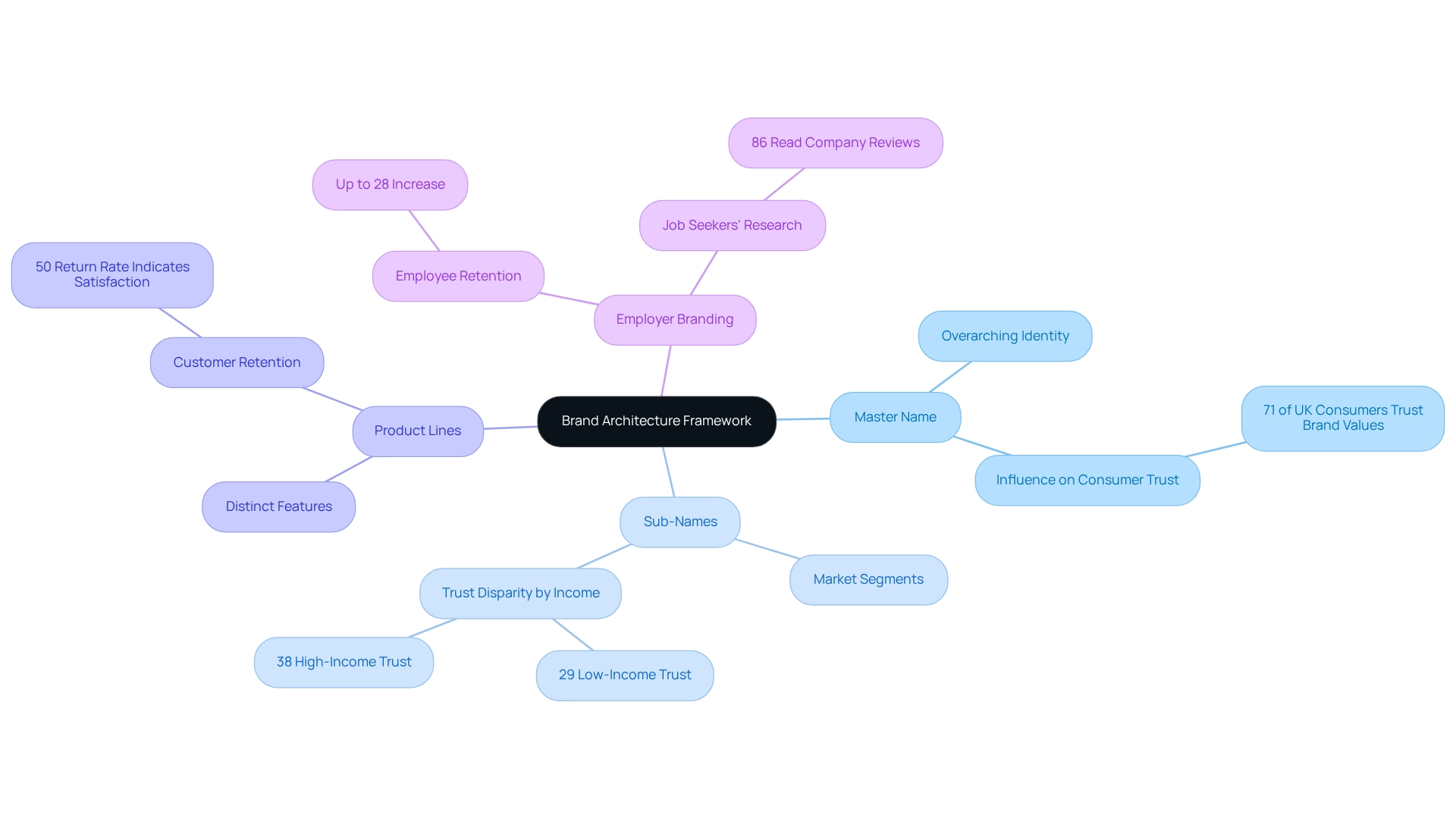
The Significance of Brand Architecture in Driving Business Growth
The brand architecture framework is essential for driving company growth, as it provides clarity and structure to a firm’s branding efforts. A well-defined identity not only differentiates companies in a competitive market but also enhances public understanding of their products. This clarity is particularly crucial, especially as 80% of shoppers are increasingly purchasing products directly through social media platforms in 2025. This trend underscores the necessity for companies to present a cohesive identity across all channels.
Moreover, an effective organizational structure promotes cross-promotion among sub-brands, significantly enhancing overall brand value. Businesses that have established a robust brand architecture framework are better equipped to adapt to market changes and shifting consumer preferences, leading to increased sales and customer loyalty. For instance, companies that prioritize authenticity in their marketing strategies see substantial benefits, with 88% of consumers valuing transparency, which can mitigate negative backlash and foster loyalty.
Additionally, only 29% of low-income individuals trust their labels compared to 38% of affluent consumers, highlighting the critical importance of building trust through a well-structured label framework.
Aligning label structure with business objectives within a brand architecture framework enables organizations to create a unified strategy that promotes long-term growth. In 2025, the impact of product structure on sales growth is expected to be significant, with marketing leaders emphasizing its role in enhancing revenue and competitive advantage. Personalization in marketing is also vital, as 87% of individuals report that personally relevant content positively influences their perceptions of a brand.
Companies such as Castania and Motorola exemplify how effective identity structure can lead to market differentiation and measurable success. By investing in a clearly defined brand architecture framework, organizations can strengthen their market presence and ensure that their marketing initiatives resonate with consumers, ultimately contributing to sustained growth.
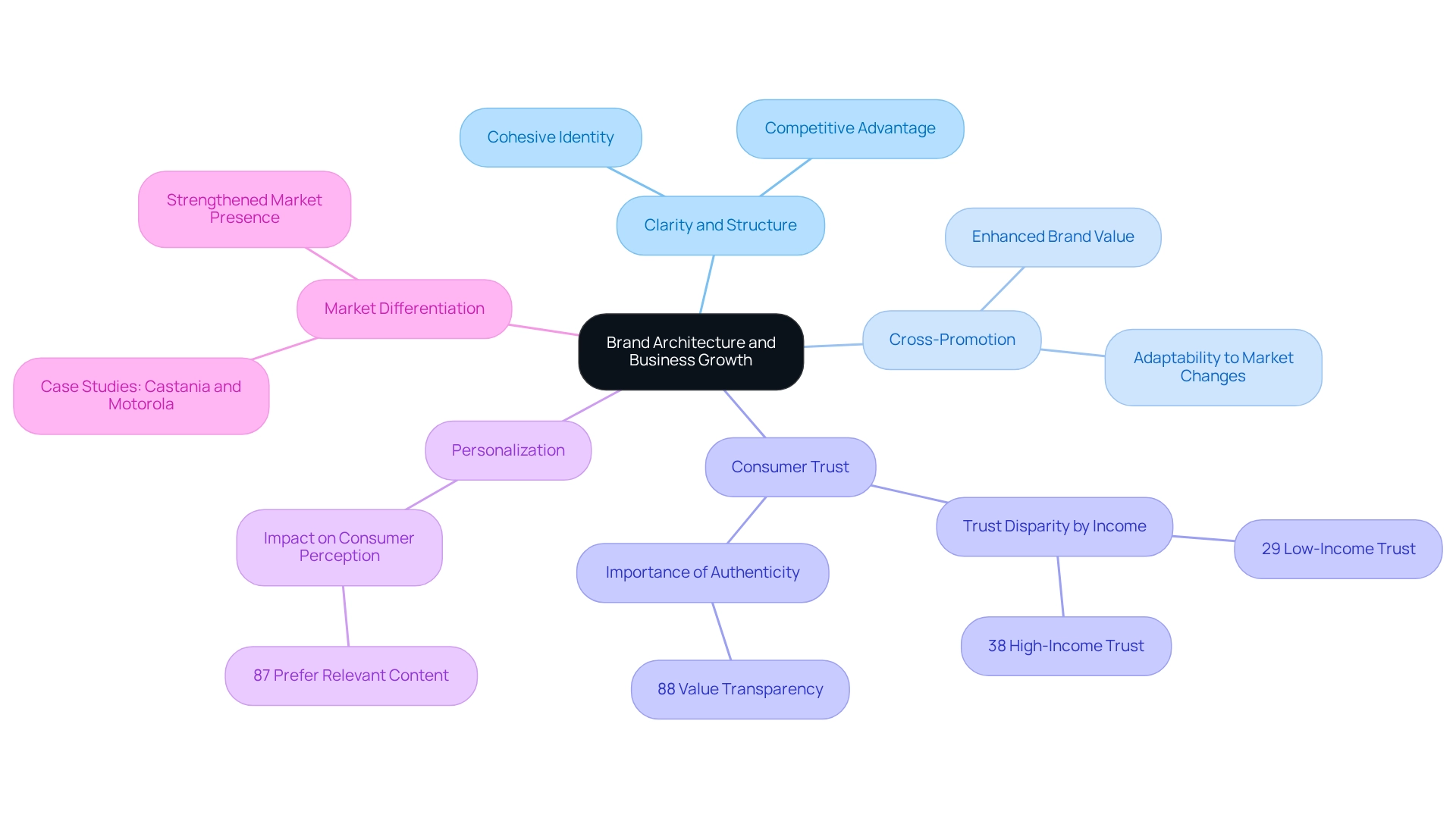
Exploring Different Types of Brand Architecture: Models and Frameworks
Brand architecture frameworks are essential models that enable companies to effectively organize their portfolios. The primary models include:
- Branded House: This model features a single master label that encompasses all products and services, fostering a cohesive identity. A prime example is FedEx, where the company’s strength enhances the visibility of its various services. This approach aligns with WonderEight’s focus on creating impactful branding strategies that unify a company’s message across different platforms. WonderEight has effectively executed this model for clients, ensuring that their identity is consistently communicated across all channels.
- House of Brands: In this strategy, multiple independent labels operate under a single parent company, each maintaining its unique identity. Procter & Gamble exemplifies this approach, allowing for targeted marketing strategies tailored to different consumer segments. WonderEight can assist clients in navigating this model by creating unique identities that resonate with specific audiences. For example, one of our clients experienced a substantial rise in market engagement after we assisted them in enhancing their unique identities under a unified parent company.
- Endorsed Labels: This model includes sub-labels that are supported by the parent entity, gaining from its established reputation while maintaining their uniqueness. Courtyard by Marriott illustrates this, where the endorsement adds credibility without overshadowing the sub-brand’s identity. WonderEight’s expertise in strategy development can assist businesses in effectively implementing this model, as shown by our work with a hospitality client who successfully launched a new sub-identity with our guidance.
- Hybrid Model: Combining elements of both the branded house and house of brands, this model offers flexibility in brand management. It enables businesses to utilize the strengths of both strategies, adjusting to market demands and buyer preferences. As businesses seek to enhance their market presence, WonderEight’s innovative marketing approaches can support the implementation of hybrid strategies. Our recent partnership with a tech firm demonstrated how a hybrid model can effectively address various consumer needs while preserving a strong overall identity.
Recent statistics indicate that product extensions within a branded house often capture greater market share and achieve higher advertising efficiency compared to independent labels. This trend underscores the effectiveness of a unified brand strategy in today’s competitive landscape. As Brad Gillum aptly states, “We’re consultants who happen to specialize in marketing.”
We help people and have fun doing it. This viewpoint emphasizes the significance of strategic branding in reaching organizational objectives.
As businesses navigate their branding strategies, understanding these models is crucial for selecting the brand architecture framework that aligns with their objectives and market positioning. Current trends in 2025 suggest a growing preference for hybrid models, reflecting the need for adaptability in an ever-evolving marketplace. By examining successful case studies, like the Taj Hotels’ identity framework overhaul, companies can gain insights into the practical implications of these models and make informed decisions about their marketing strategies.

Benefits of a Strong Brand Architecture: Why It Matters
A robust brand architecture delivers a multitude of advantages that can profoundly influence a company’s trajectory:
-
Clarity and Consistency: A well-defined organizational architecture establishes a coherent framework for messaging, ensuring that all communications maintain consistency across various channels. This clarity strengthens corporate identity and fosters trust among consumers. Significantly, 86 percent of B2B clients anticipate businesses to be knowledgeable about their personal information during service interactions, emphasizing the necessity of transparency in communications.
-
Improved Customer Experience: By systematically arranging products and services, the structure of the company allows customers to explore offerings effortlessly. This logical structure simplifies the decision-making process and significantly enhances the overall customer experience, leading to increased satisfaction and loyalty. As Esat Artug, Product Marketing Manager, notes, “Most business leaders (89%) believe personalization is critical to their company’s future success,” underscoring the role of tailored experiences in customer satisfaction.
-
Enhanced Value: A carefully designed identity framework strengthens recognition and loyalty, which are essential elements of value. Businesses that emphasize robust identity structures frequently experience increased customer retention levels, as consumers are more inclined to stay loyal to names they comprehend and trust.
-
Efficient Marketing: With a clear identity framework in place, marketing efforts can be more focused and effective. This reduces overlap and confusion in campaigns, allowing for a more streamlined approach that maximizes impact and minimizes wasted resources. Notably, companies that grow faster derive 40 percent more revenue from personalization than their slower-growing counterparts, underscoring the importance of tailored marketing strategies.
-
Facilitated Growth: Robust identity architecture establishes the foundation for successful extensions and new product introductions. By establishing a strong foundation, it enables companies to launch new offerings without undermining the essence of the core identity. This adaptability is crucial in today’s fast-paced market, where consumer preferences can shift rapidly.
By integrating perspectives from marketing experts, it is clear that a robust identity framework not only improves customer experience but also propels organizational success. For example, the University of Tulsa’s execution of a streamlined design process through effective identity structure significantly enhanced their marketing efficiency, showcasing the tangible advantages of a well-organized method. As companies continue to advance, the significance of a unified identity framework will only increase, rendering it a crucial element of any effective marketing strategy.
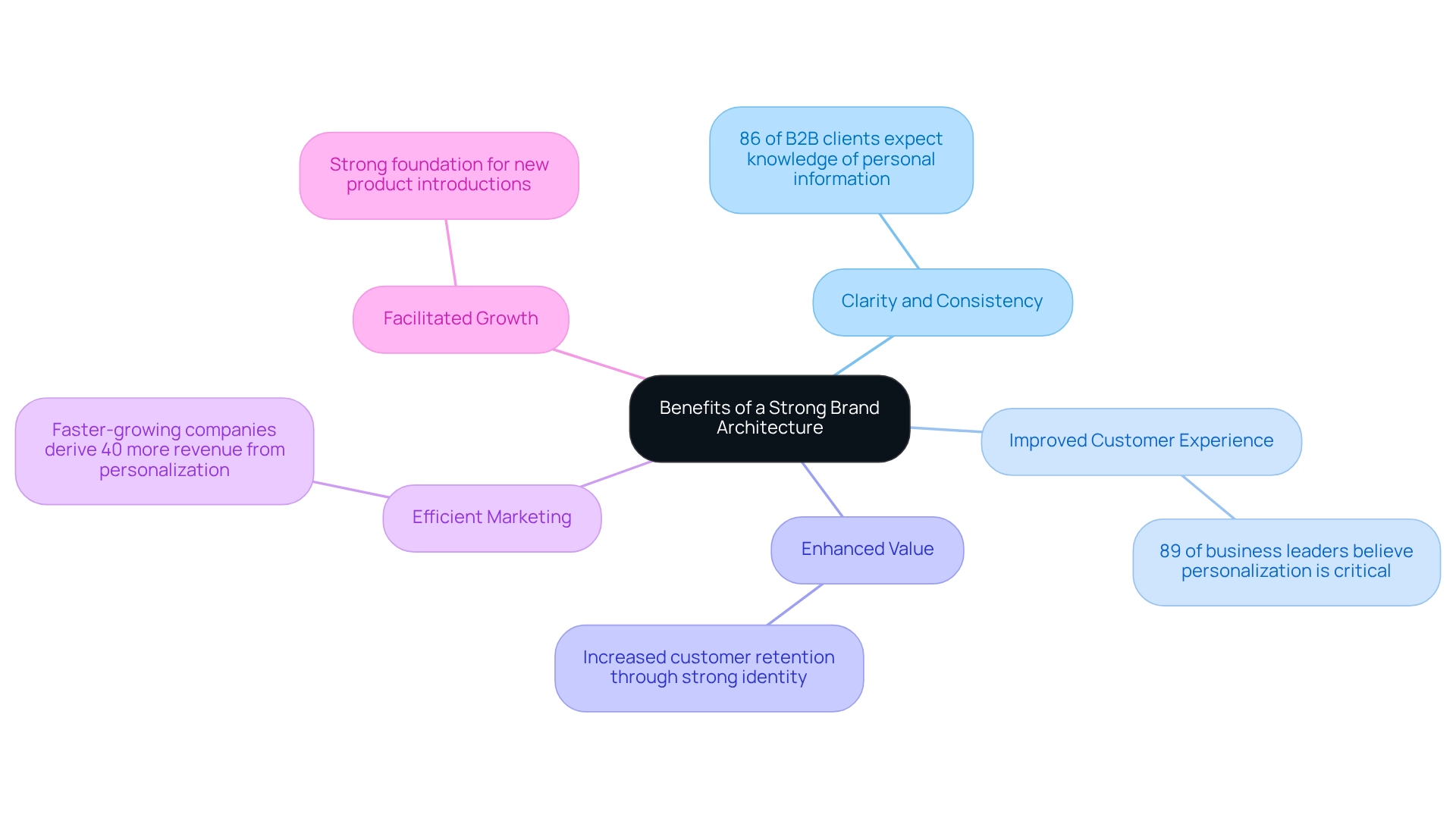
Step-by-Step Guide to Building Your Brand Architecture Framework
Creating a framework for a company’s structure is a strategic process that encompasses several crucial steps:
-
Conduct a Portfolio Audit: Begin by evaluating your current product lineup. This involves identifying strengths, weaknesses, and areas for improvement. Real-world instances, such as Coca-Cola’s hybrid structure and its diversification in response to changing consumer preferences, illustrate the significance of a thorough audit in understanding positioning. Furthermore, Starbucks’ standardization of marketing serves as another example of how effective audits can guide branding strategy. At WonderEight, we provide thorough digital audits that can assist you in gaining insights into your company’s performance and recognizing key areas for improvement.
-
Establish Organizational Objectives: Align your identity framework with your overall corporate aims. This alignment ensures that your branding efforts support the brand architecture framework, thereby enhancing strategic coherence and driving measurable outcomes. For example, Apple’s emphasis on customer satisfaction has been crucial in influencing its identity. WonderEight can help in creating a digital strategy that aligns with your organizational goals, ensuring your identity framework supports your broader objectives.
-
Choose a Model: Select the company structure model that best suits your business requirements and market positioning. Options include monolithic, endorsed, and hybrid models. A significant illustration is Marriott, which utilizes an endorsed structure, lending legitimacy to its various sub-brands such as Residence Inn by Marriott and Courtyard by Marriott. Our team at WonderEight can guide you in selecting the most effective model for your brand.
-
Map Relationships: Clearly outline the connections between the master label, sub-labels, and products. This clarity aids in comprehending the roles each label plays within the overall structure, facilitating improved consumer recognition and loyalty. Our social media management services can enhance these relationships by ensuring consistent messaging across platforms and engaging audiences effectively.
-
Develop Guidelines: Create comprehensive guidelines that outline how each entity should be represented visually and verbally. This ensures consistency across all touchpoints, which is essential for maintaining identity integrity. As emphasized by The Design Council, 73% of consumers make purchasing choices based on a product’s visual attractiveness, underscoring the significance of effective representation. WonderEight specializes in website and app design, ensuring your digital presence aligns with your branding guidelines. Furthermore, our SEO consultancy can enhance your online presence, further supporting your identity structure.
-
Implement and Monitor: Launch the company structure across all marketing channels. Continuous monitoring of its effectiveness is vital; be prepared to make adjustments as necessary to optimize performance. Case studies, like the extensive campaign carried out for Quaker Oats by WonderEight, illustrate how creative marketing strategies can greatly enhance consumer involvement and product interaction, emphasizing the significance of aligning identity structure with broader organizational objectives. Our CRM approach and execution services can also assist in monitoring customer interactions and improving loyalty.
By following these steps and utilizing the comprehensive digital and marketing solutions provided by WonderEight, businesses can create a strong brand architecture framework that enhances visibility and aligns with broader business objectives.
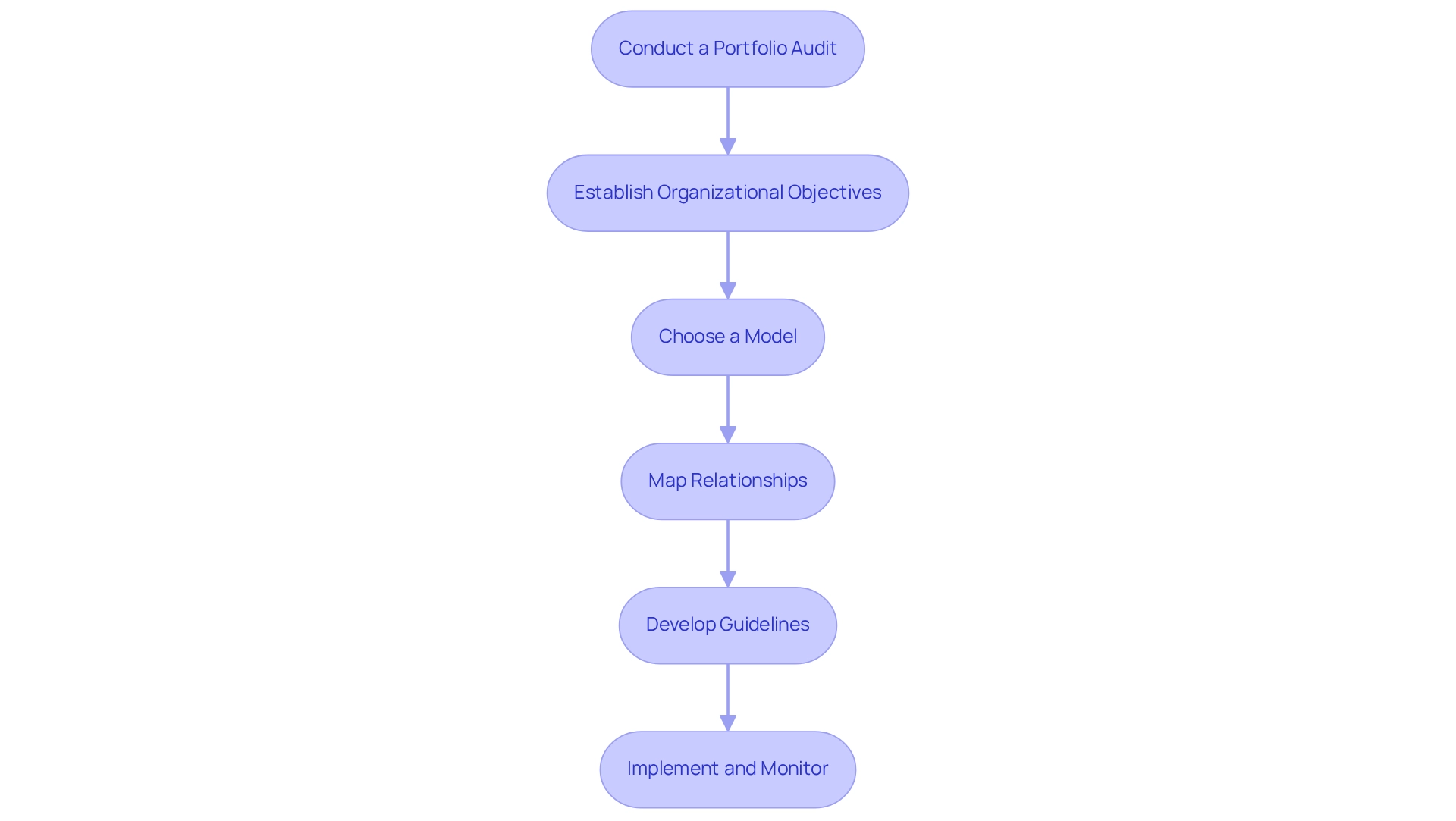
Navigating Challenges in Brand Architecture Development
Creating a framework for architecture presents significant challenges that organizations must manage efficiently.
-
Complexity of Existing Labels: Companies with a diverse portfolio often struggle to define clear relationships and hierarchies among their labels. This complexity can lead to confusion both internally and externally, making it imperative to establish a coherent structure that aligns with the overall business strategy.
-
Resistance to Change: Change frequently encounters resistance from employees and stakeholders accustomed to existing branding structures. This resistance may arise from fear of the unknown or a lack of understanding regarding the advantages of a new branding strategy. A survey by Marketing Week highlighted that 50% of marketers find it challenging to accurately assess performance due to a lack of reliable metrics, complicating the transition to a new framework. Engaging stakeholders early in the process and effectively communicating the benefits of the new design can mitigate this challenge.
-
Market Dynamics: The rapid pace of change in market conditions complicates the development of product architecture. Businesses must remain flexible and adaptable, ready to adjust their strategies in response to shifting buyer preferences and competitive pressures. For instance, companies prioritizing authenticity and emotional connection are more likely to resonate with consumers, as recent findings reveal that 89% of individuals remain loyal to organizations that align with their values.
-
Resource Allocation: Limited resources can impede the ability to conduct thorough audits and implement new strategies effectively. Organizations may struggle to allocate sufficient time and budget for comprehensive evaluations of their identity, which are crucial for informed decision-making.
To effectively address these challenges, businesses should prioritize stakeholder involvement from the outset, ensuring that all parties understand the rationale behind the brand architecture framework. Furthermore, maintaining open lines of communication about the benefits of the changes fosters a more supportive environment. Successful campaigns for companies like Mirinda and Quaker Oats illustrate that effective communication and strategic implementation enhance visibility and consumer connection, ultimately leading to improved performance.
These campaigns successfully engaged audiences, showcasing how addressing identity structure challenges can yield tangible results. Moreover, consistent product presentation across all platforms can increase revenue by as much as 23%, underscoring the importance of a well-organized identity framework in achieving organizational objectives.
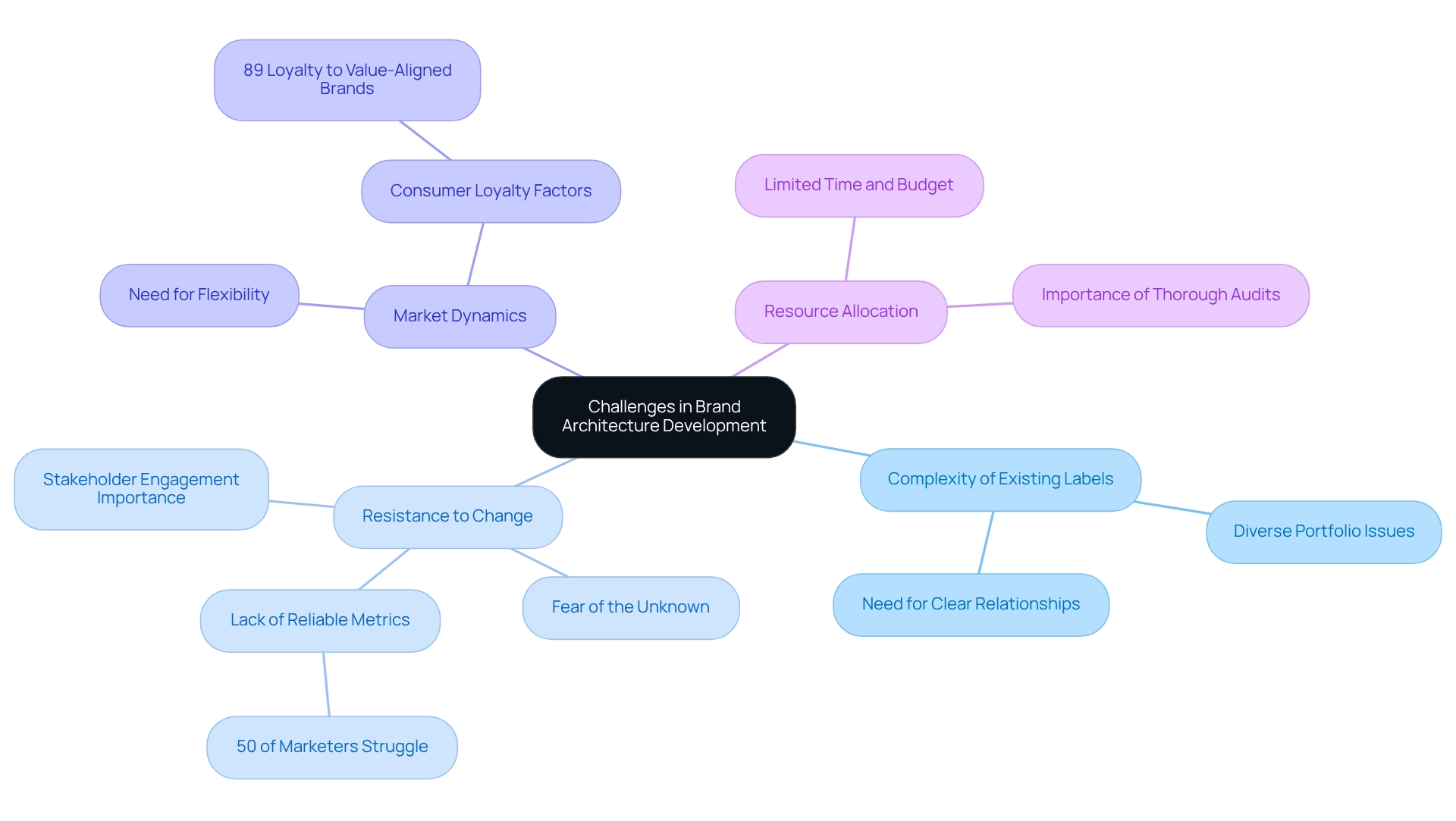
Aligning Brand Architecture with Business Objectives for Maximum Impact
Aligning company structure with business goals is essential for maximizing effectiveness. To ensure this alignment, consider the following steps:
-
Understand Business Goals: Clearly define your organization’s short-term and long-term objectives. This fundamental comprehension of the brand architecture framework will guide your identity structure decisions, ensuring they are strategically aligned.
-
Engage Stakeholders: Actively involve key stakeholders throughout the development process. Their insights are invaluable in ensuring that the company’s structure accurately reflects its vision and values. A study indicates that only 41% of employees feel they understand what their company does and how it differentiates itself from competitors. This highlights the need for effective communication and engagement, which promotes a shared understanding of the organization’s direction and enhances overall alignment.
-
Establish Cooperation: Each label within your brand architecture framework should support the overall corporate strategy. This synergy enhances coherence and effectiveness, allowing sub-brands to cross-sell between audiences and share values with the parent company, ultimately boosting equity. By ensuring that sub-brands are aligned within the brand architecture framework and with overarching organizational objectives, companies can leverage their collective strengths to drive growth and market presence.
-
Monitor Performance: Regularly evaluate the effectiveness of your company structure against set organizational goals. Routine product audits enable business leaders to proactively manage their strategy, ensuring alignment with evolving market conditions and consumer behaviors. Conducting a competitive analysis is essential in this process, as it helps identify areas of excellence and improvement, providing valuable insights and opportunities for differentiation.
Integrating expert perspectives and case studies can further clarify the significance of stakeholder involvement in identity structure development. Successful stakeholder engagement examples illustrate how collaborative efforts can lead to more robust marketing strategies. As Chris appropriately observed, “If not, it might be time for a reputation audit to realign your strategy.”
This proactive approach not only identifies areas for improvement but also uncovers opportunities for differentiation in a competitive landscape.
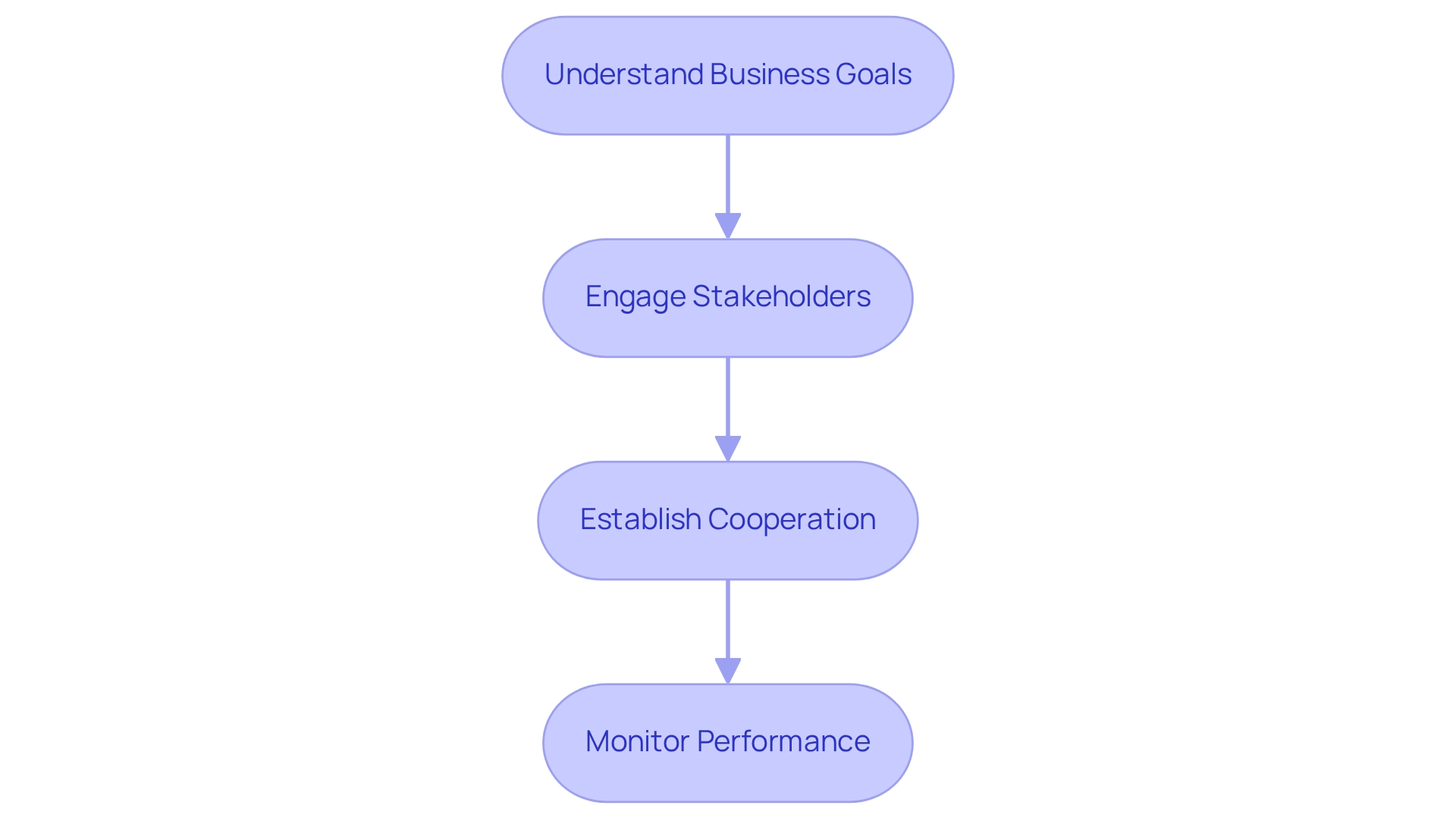
Case Studies: Successful Brand Architecture in Action
Examining successful case studies offers invaluable insights into effective product architecture.
FedEx stands as a prominent instance of a branded house, having skillfully integrated its services under a unified identity. This strategic alignment not only enhances name recognition but also fosters customer loyalty, as clients associate the FedEx name with reliability and comprehensive service offerings. The impact of this method is evident, with research indicating that companies boasting robust architecture can experience a significant increase in customer loyalty. Notably, 13% of companies fail to enforce their guidelines, underscoring the importance of maintaining consistency in visual identity structure.
Procter & Gamble employs a house of products strategy, effectively managing a diverse portfolio of offerings. Each label retains its distinct identity while benefiting from the overall reputation of the parent company. This model enables P&G to cater to different market segments without compromising its value, illustrating how a well-organized identity framework can lead to sustained market success.
Courtyard by Marriott exemplifies the endorsed label model, leveraging the Marriott name to provide a strong foundation while carving out its own identity. By appealing to a specific market segment—business travelers seeking comfort and convenience—Courtyard successfully differentiates itself within the competitive hospitality landscape.
Nike’s hybrid organizational structure efficiently categorizes its product lines to meet various customer requirements. By maintaining adaptability in its marketing approach, Nike can respond to market trends and buyer preferences, facilitating growth and reinforcing its status as a leader in the athletic apparel sector.
These examples illustrate how different brand architecture frameworks can be strategically utilized to achieve organizational goals, emphasizing the significance of aligning identity with customer expectations and market demands. As Leslie de Chernatony observes, a more flexible management approach is essential today, prioritizing values management over rigid oversight. This perspective is crucial in the digital era, where identity development faces new challenges that require an emphasis on consumer advantages rather than solely organizational gains.
Furthermore, the complexities associated with marketing geographic areas highlight the diverse nature of branding frameworks, indicating that while challenging, effective management of identities is both possible and vital.
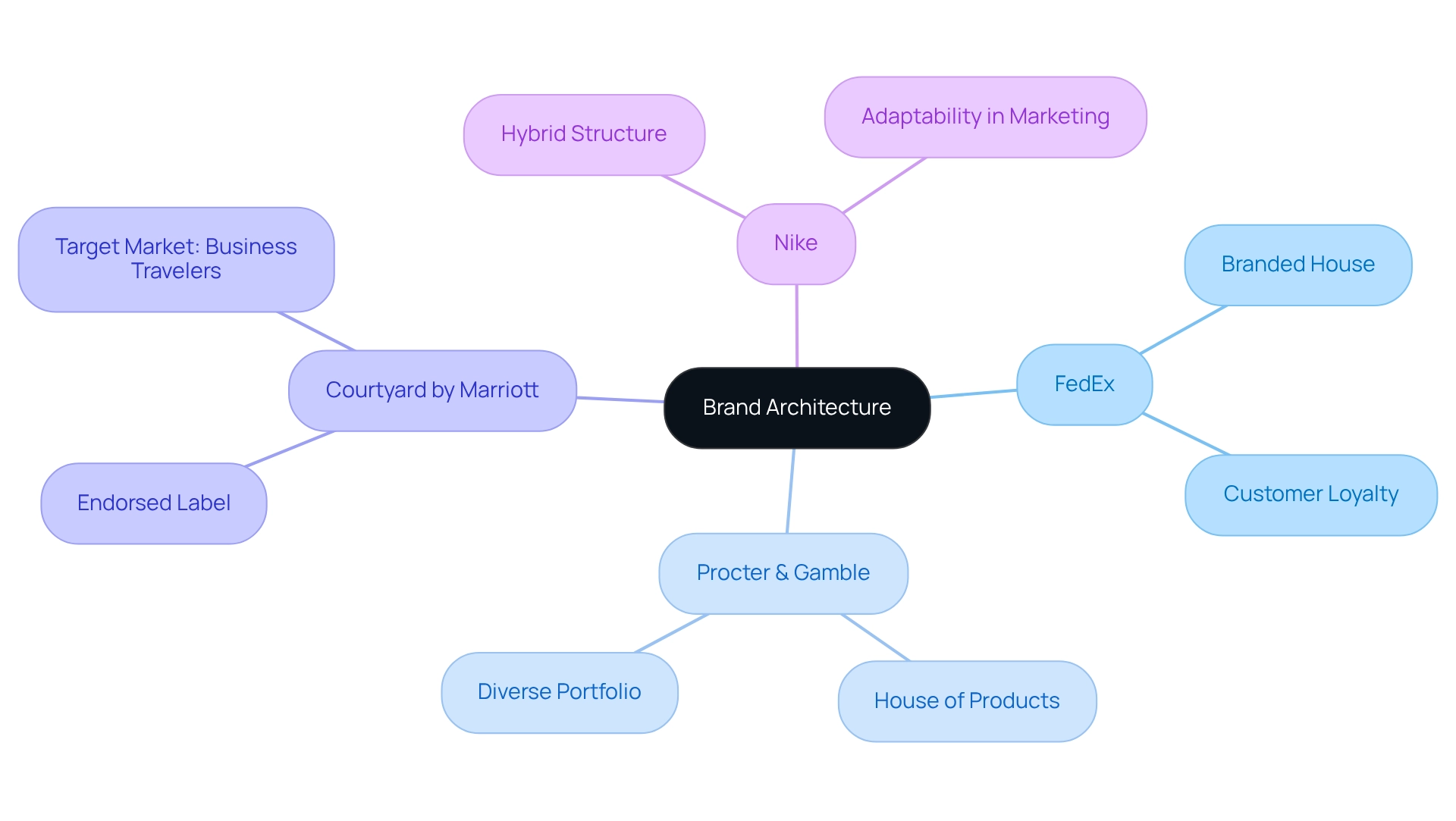
Future Trends in Brand Architecture: What to Expect
The branding environment is undergoing significant transformation, driven by several key trends that will shape the future of identity structure:
-
Heightened Attention to Sustainability: As environmental awareness increases among consumers, companies are aligning their structures with sustainable practices. Research indicates that companies prioritizing sustainability achieve a 4% higher annual return compared to their counterparts. This alignment not only bolsters reputation but also contributes to a brand architecture framework that fosters sustainable growth.
-
Personalization and Customization: Leveraging data to create personalized experiences is becoming essential. This trend necessitates adaptable identity structures that can respond to individual consumer preferences, ensuring that brands remain relevant and engaging.
-
Integration of Technology: With the rise of digital platforms, companies are reassessing their structures to enhance online presence and interaction. Recent reports reveal that 70% of design firms plan to increase technology investments in the coming year, underscoring the critical role of technological integration in marketing strategy.
-
Focus on Brand Purpose: Modern consumers are increasingly drawn to companies that demonstrate a clear purpose. This shift is leading to designs that embody core principles and social accountability, aligning corporate identity with consumer expectations.
These trends not only shape how companies define their identities within the brand architecture framework but also influence how they communicate their values and engage with their audiences. The case of Gi Group exemplifies the necessity of a clearly defined identity framework. As the company expanded, it introduced ‘Gi Group Holding’ to clarify its positioning and ensure coherence across its various entities.
This strategic move refined the label’s identity and enhanced its market presence. Moreover, a well-structured brand architecture framework aligns internal forces towards a common goal, clarifying the company’s vision for sustainable growth. Staying abreast of these evolving trends is vital for companies aiming to adapt their structures to meet shifting consumer demands and market dynamics.
As Josh Howarth notes, confidence in companies varies significantly across income levels, with only 29% of low-income earners expressing trust compared to 38% of high-income shoppers. This disparity underscores the need for companies to build trust through transparent and purpose-driven frameworks. Additionally, with 86% of job seekers consulting company reviews prior to applying, the influence of brand architecture on employer branding and recruitment is paramount.
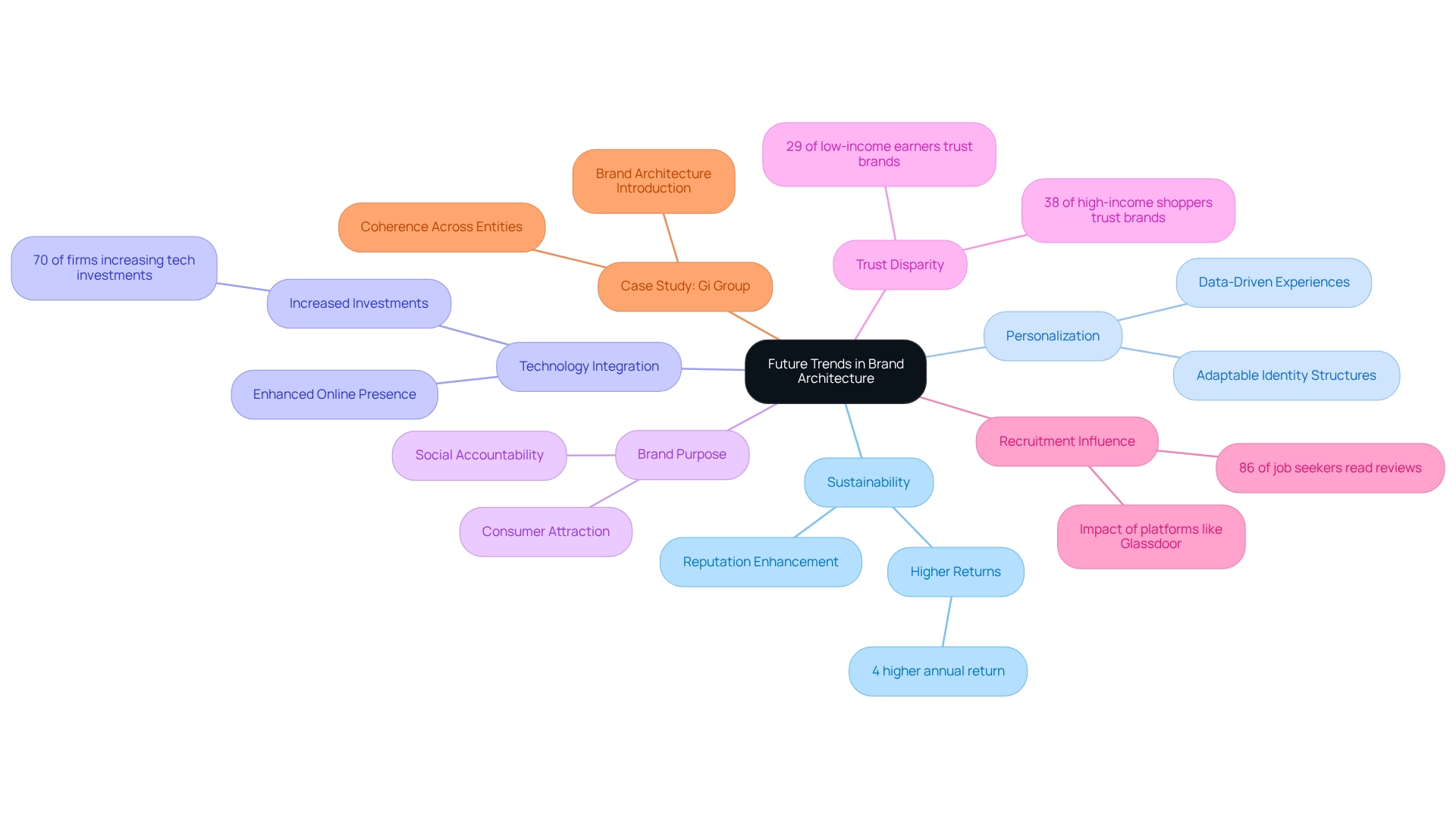
Conclusion
A well-structured brand architecture is indispensable for businesses aiming to excel in today’s competitive marketplace. It not only clarifies the relationships among various brands and products but also acts as a strategic guide that enhances consumer understanding and loyalty. By establishing a cohesive identity, companies can effectively communicate their values, which, as recent studies indicate, significantly influence purchasing decisions.
The advantages of robust brand architecture are numerous, including increased brand equity, improved customer experience, and streamlined marketing efforts. This foundational framework empowers businesses to adapt to market changes and consumer preferences, ultimately driving growth and ensuring long-term success. Companies like FedEx and Procter & Gamble exemplify how diverse brand architecture models can be successfully implemented to achieve organizational goals while maintaining consumer trust.
As the branding landscape continues to evolve, organizations must remain vigilant in aligning their brand architectures with broader business objectives. Engaging stakeholders, monitoring performance, and adapting to emerging trends such as sustainability and personalization will be crucial for maintaining relevance. In an era where consumer trust and brand purpose are paramount, investing in a robust brand architecture will not only enhance market presence but also cultivate lasting relationships with consumers. Embracing these principles will pave the way for sustained growth and success in the future.
Frequently Asked Questions
What is the brand architecture framework?
The brand architecture framework is a strategic system that defines the relationships among a company’s labels, sub-labels, products, and services. It guides communication and shapes perceptions in the marketplace.
What are the key components of the brand architecture framework?
The key components include the master name (overarching identity), sub-names (targeting specific market segments), and product lines (offering distinct features or advantages).
Why is understanding brand architecture important for companies?
Understanding brand architecture is vital for companies to cultivate a cohesive identity, manage their branding portfolio effectively, and ensure alignment with their strategic vision.
How does product structure impact consumer perception?
In 2025, 71% of individuals in the UK indicated that company values significantly influence their purchasing decisions, highlighting the importance of clearly articulating values within the brand structure.
What role does organizational design play in customer loyalty?
Effective organizational design can enhance customer loyalty, with statistics showing that if 50% of clients return within a year, it indicates strong commitment and satisfaction with the company.
How does employer image affect job seekers?
86% of job seekers consult company reviews before applying, emphasizing the importance of a positive reputation in attracting talent.
What insights do experts provide regarding trust in branding?
Trust varies across income levels, with only 29% of low-income earners expressing confidence in their labels, compared to 38% of high-income consumers, underscoring the importance of branding design in building trust.
What are the primary models of brand architecture?
The primary models include: 1. Branded House: A single master label for all products (e.g., FedEx). 2. House of Brands: Multiple independent labels under one parent company (e.g., Procter & Gamble). 3. Endorsed Labels: Sub-labels supported by the parent entity (e.g., Courtyard by Marriott). 4. Hybrid Model: A combination of branded house and house of brands, offering flexibility.
How do companies benefit from a well-defined brand architecture framework?
A well-defined framework provides clarity, enhances public understanding of products, promotes cross-promotion, and allows companies to adapt to market changes, ultimately leading to increased sales and customer loyalty.
What current trends are influencing brand architecture models?
In 2025, there is a growing preference for hybrid models, reflecting the need for adaptability in an evolving marketplace. Companies are encouraged to examine successful case studies to inform their branding strategies.



